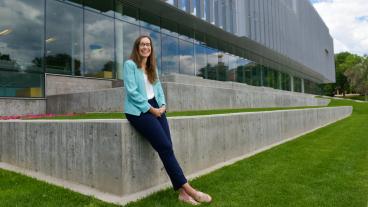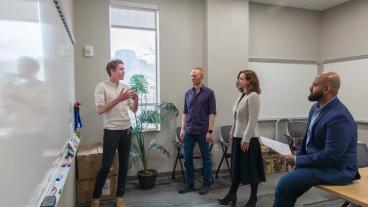A steady, reliable, enormous, practically inexhaustible, carbon-free source of electric power, one capable of producing three times the wattage the United States generates each year, is right under our feet. Or more accurately, way under our feet, where it has long tantalized geothermal energy experts.
Now the very technologies that ushered in America’s oil and gas boom may be putting this resource within reach. A collaboration between Mines and the U.S. Department of Energy’s (DOE) National Renewable Energy Laboratory (NREL) is working across several fronts to use the tools of modern hydrocarbon extraction to exploit a potentially game-changing clean energy resource.
The concept behind enhanced geothermal systems (EGS) is simple: inject water into hot, dry rock; let the hot rock heat the water; extract the hot water as a steam; drive a turbine with the steam; produce electricity; re-inject the cooled-off water and repeat. Appropriately enough for an infernal, netherworldly resource, the devil is in the details.
The Mines-NREL “Colorado Collaboration for Subsurface Research in Geothermal Energy” (Colorado SURGE) is gettinginto those details on projects spanning geothermal reservoir characterization, drilling approaches and water treatment. The effort, launched in 2014, is being paid for by funding from DOE starting with $800,000 in 2014 and $1.2 million in 2015. Future years funding will depend on the progress and independent review of proposals, but the Colorado SURGE team is planning for growth.
“The idea of adapting advanced oil and gas technologies for geothermal was a very high priority for the DOE,” said Dag Nummedal, who directs Mines’ Colorado Energy Research Institute and worked with NREL to launch SURGE. In early 2015, Mines Professor Wendy Harrison, just back from an 18-month appointment leading the National Science Foundation’s Earth Sciences Division, took over SURGE leadership at the school.
Tom Williams, who directs NREL’s Geothermal Technologies Program and federal lab’s side of SURGE, said NREL had recognized that the lab lacked capabilities in geology, oil and gas technology, water treatment and other areas critical to EGS — not to mention access to students. Mines, right up the road, was the obvious choice, he said.
The conclusion so far, said those involved, is that while the technology piece is tough, the real hurdles are economic. The key, they said, will be to improve an array of technologies and techniques, particularly on the drilling side, to bring the costs down.
First, a bit about the potential prize. A 2008 U.S. Geological Survey estimate considering the heat below 13 western states suggested a potential geothermal resource of 345 gigawatts to 727 gigawatts. In 2011, Google.org and Southern Methodist University’s Geothermal Laboratory estimated the “technical potential” of enhanced geothermal (that is, accessible at depths of 3.5 to 6.5 km and excluding places like national parks and other protected lands), to be 2,980 gigawatts. To put that in perspective, the entire U.S. electrical generation capacity amounted to 1,051 gigawatts in 2011. What’s more, geothermal energy produces baseload power, a steady source that doesn’t care if the sun is shining or the wind is blowing.
But you’ve got to get down there, and the shallow side of EGS is the deep end of oil and gas drilling. To tap into temperatures above 150 degrees Celsius (302 degrees Fahrenheit, the minimum for geothermal power production) in places like Michigan and Florida, you’d need to drill down about 10 kilometers — deeper than Mount Everest is tall. And that’s just the beginning.
The most favorable EGS targets in the West are in granitic rock, as opposed to the sedimentary formations where tight oil and gas are harvested, “So drilling’s a lot slower,” said Professor William Fleckenstein. How hydraulic fracturing might work in such rock at high temperatures and pressures isn’t well-understood, either. EGS wells will need larger diameters, adding to costs that an MIT team estimates will be twice to five times more costly than an oil and gas well. Factor in that the oil and gas drilling costs skyrocket with depth, with an average of $600,000 at a depth of two kilometers leaping to $10 million or more at six kilometers, the MIT team found.
Covering costs like that will take a lot of hot water, said Associate Professor Bill Eustes, one of the principal investigators for Mines’ SURGE research. NREL estimates a barrel of EGS brine to be worth maybe 50 cents, or about 100 times less than a barrel of oil. So the Mines/NREL team has made 100,000 barrels of water a day its baseline flow — 10 times that of a big-producing oil and gas well, said Assistant Professor Luis Zerpa.
Zerpa’s team is adapting oil and gas reservoir models for EGS in sedimentary basins. Traditional geothermal involves crystallized rock, Zerpa said, but sedimentary rock is much more common under the continental U.S. They’re considering vertical drilling for now, but will soon be modeling horizontal wells. So far, EGS looks like “a technical challenge that can be overcome,” he said.
Associate Professors Wendy Zhou and Masami Nakagawa are leading work on an EGS test at the university’s Edgar Mine in Idaho Springs, Colo., which will be used to understand rock-water heat transfer and how fluid flows through fractures in igneous rocks. Zhou’s expertise in 3D subsurface modeling is coming into play, as the positioning and angling of boreholes will depend on the orientation of joints, fractures, faults, bends and other rock discontinuities, among other factors.
Eustes and Fleckenstein have two undergraduates and a graduate student looking at the feasibility of horizontal geothermal completions. Other graduate students are doing EGS fracture stimulations and studying thermal cycling on casing strings and other drilling hardware. Nine Mines undergraduates are looking at drilling performance of oil and gas versus traditional wet-rock geothermal, trying to tease out the limitations and gain insight into what might be done to improve drilling operations, Eustes said.
Water quality will be an important part of EGS operations. “If you recirculate it again and again through a porous medium, you pick up particles and sand grains,” said Associate Professor Tzahi Cath, who directs Mines’ Advanced Water Technology Center (AQWATEC) and leads two EGS-related projects. “If you don’t take the impurities out, you can plug the injection well.”
One of Cath’s EGS projects, part of SURGE, involves enhancing a water modeling system his team developed for the oil and gas industry. It takes into account factors including how dirty the input water is, the required level of purification, treatment approaches (chemical, distillation, nanofiltration, reverse osmosis), electricity or heat constraints, and an economic module that costs out infrastructure. About 30 undergraduate chemical engineering students are working on different EGS “water treatment trains” developed from the model’s predictions as part of their capstone work, Cath said.
Cath’s other EGS work is on a three-year, $2.6 million DOE-funded project with Yale University. Started in 2013, it involves using the heat from water at temperatures expected at the tail end of an EGS power plant to drive two membrane processes (membrane distillation and pressure-retarded osmosis), harnessing chemical energy to create mechanical energy to drive a turbine. A bench-scale machine is up and running and a pilot-scale system is nearing completion.
Mines and other EGS researchers around the world have a long way to go. Globally, EGS is in the demonstration stage, with commercial deployments yet to come. But Williams said DOE is playing the long game, and he sees EGS as a “very early-stage technology,” akin to photovoltaics in the early 1960s, when solar panels cost thousands of dollars per watt (today, rooftop panels can be had for less than $1 a watt).
EGS, at the nexus of energy and the environment, “fits beautifully into the long term mission and vision of Mines,” Nummedal said. “Students keep coming here because this is a vision they’re increasingly aligned with. It’s not one or the other anymore – it’s both.”
This story originally appeared in the 2015-16 issue of "Colorado School of Mines Research."



